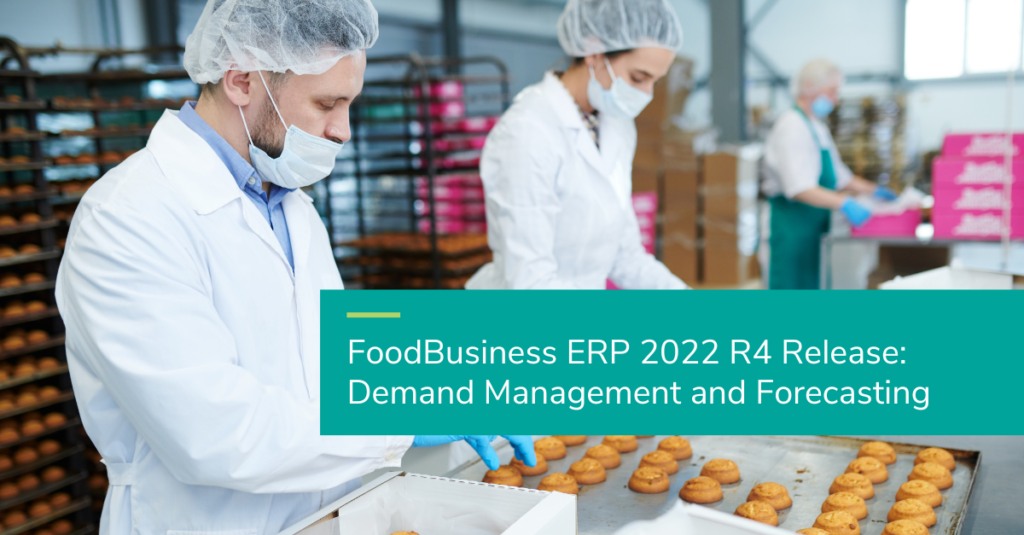
Food and beverage manufacturers face mounting challenges, including the continuing labor shortages and rising inflation. These and many other challenges are affecting manufacturers’ ability to create lean, profitable businesses, and this unsettling and fluid environment has caused manufacturers to turn to modern food software, like FoodBusiness ERP, to help them overcome the never-ending issues. At FoodBusiness ERP, we understand it’s a difficult time, and we take the responsibility of providing manufacturers with innovative, problem-solving food manufacturing software very seriously.
In fact, we never stop improving our product based on our customers’ unique needs, and we’re excited to introduce our latest release, FoodBusiness ERP 2022 R4. This release offers two major, industry-specific updates: Retains and Reference Sample Management (check out the details in this recent article), and Demand Management and Forecasting, which we’ll examine more closely today.
Past and Future with FoodBusiness ERP’s New Features
Prior to FoodBusiness ERP 2022 R4, FoodBusiness ERP provided forecasting functionality, and for most of our customers, this base functionality met their needs. However, we wanted to expand this capability so that manufacturers could leverage the data and capabilities of FoodBusiness ERP to learn from the past and apply their knowledge to the future. With our new Demand Management and Forecasting features, they can.
The best way to understand the updated functionality brought by these new features is by discussing two fairly distinct activities: demand history and forecast calculation and management.
Demand History
Demand forecasting is the act of using historical data (demand history) to predict future demand for a product (or service). Though a simple concept, there are certain things that can skew demand history. One example is a lost sale.
Simply put, a lost sale is when a customer orders a product, but a business has insufficient inventory, resulting in the customer’s order closing without a sell. When looking at a demand history of orders, this lost order will not appear unless the manufacturer specifically looks for that information—information that could be factored into the forecast and used to produce more product so that this type of lost sale doesn’t occur again. Manufacturers must have the means to capture and manage them.
Another forecasting challenge is the advent of unusual events. Examples of unusual events include a natural disaster, new production introduction, product replacement, or opening a new facility—all of which produce dips or spikes in demand. Without the ability to edit this information out, the forecast will be inaccurate. Further, to fully understand demand history, one needs sales history and real-order data over an extended period of time in order to calculate a reasonable forecast.
Now, with our updated Demand Management feature, manufacturers have the tools to easily import historical data from another application and to begin using our food manufacturing software to capture past and new data, edit the data, view the data in a graphical format, and use the data to “calculate forward” the minute they implement it.
This leads us to the forecast calculation and management aspect of our latest features.
Forecast Calculation and Management
In forecasting, there are many types of calculations and models. Manufacturers may vary in their forecasting needs, but forecast calculation and management is often a vital aspect of their business.
With FoodBusiness ERP 2022 R4’s new forecasting feature, we’ve addressed common challenges. Manufacturers can now:
- Have advanced and simple calculation methods, allowing them to use demand history to determine trends and calculate forecasts, including provisions for seasonality or alternatively apply a percentage—plus or minus—to the previous year’s values based on high-level business projections.
- Calculate individual product or SKU in real time and see the results on a single screen.
- Calculate batches of products or SKUs, either weekly or monthly.
- Allow for manual updates to a forecast, capture a reason code (which can be looked at in the future to see what happened) and maintain this adjustment through recalculations.
- Layer market intelligence into the forecast for exceptions (e.g., special promotions to drive volume and sales), which allows them to ensure there’s enough product to support it.
And just as we discussed with demand forecasting, we’ve supplied manufacturers with a graphical view that shows prior years’ demand, seasonal trends and the forecast. Having this information in one place helps manufacturers recognize potential problems, and produce accurate, business-enhancing forecasts.
FoodBusiness ERP: Right Sized, Easy-to-Use and Affordable
Manufacturers in today’s marketplace are looking for cost-effective forecasting tools to tackle their numerous business challenges, and they have plenty from which to choose. Unfortunately, many of these individual forecast management solutions are expensive, complicated to use, and offer more than what manufacturers require.
Before deciding on a forecasting solution, food and beverage manufacturers should consider the following questions:
- Does the forecasting solution have an existing and seamless integration with their ERP system?
- Does the solution provide more than the manufacturer needs?
- Is the return on investment enough to justify the use of a separate system?
If the answer is “no” to any—or all—of the questions, then FoodBusiness ERP is the right-sized and easy-to-use alternative. Factor in our upgraded forecast features, and manufacturers enjoy added value to our already incredibly affordable food business software.
“The entire [FoodBusiness ERP] system will pay for itself within one season,” says Joseph Wiley, MIS Director, Elmer Candy. “The savings are visible and measurable. Through labor savings, quicker turnaround, improved accuracy, strategic purchasing and streamlined processes, we are in a position to grow the business 10 to 15 percent without adding additional resources.”
For manufacturers who are interested in emulating Elmer Candy’s success, FoodBusiness ERP—built in Sage X3 and delivered by NexTec industry experts—may be the solution for which they’ve been seeking. With almost 30 years serving the food and beverage industry with a focus on ensuring the highest in food manufacturing quality, we can advise you on the best way to grow your food and beverage business.
Contact us today. We’d love to chat.

